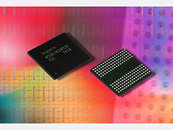Qomonda ships the first samples of GDDR5 SGRAM memory
Global memory supplier Qimonda today announced that it is has shipped the industry’s first 512MB Graphics Double Data Rate (GDDR5) samples to partners and customers.
GDDR5 SGRAM is the successor to GDDR4 SDRAM, which has yet to completely overtake GDDR3 SDRAM.
The Joint Electron Device Engineering Council (JEDEC) has not solidified the standards for GDDR5. However, JEDEC's GDDR5 special interest group is in its second year of operation, and finalized specifications may come sooner than later.
GDDR5 features data rates at 20GByte/s per component. This is double the bandwidth of the fastest GDDR3 memory.
GDDR5 operates using two different clock types. One clock type that GDDR5 comes with is a differential clock (CK), where address and command inputs are referenced. The other clock type that GDDR5 uses is the forwarded differential write clock (WCK), which operates at twice the frequency of the CK. Read and write data are referenced to the WCK.
Each write clock of GDDR5 SGRAM is assigned to two bytes.
The CK and WCK signals are aligned during the initialization and training sequence. The use of two separate clocks allows for minimal noise and jitter at high data rates
In addition to larger bandwidth and faster speeds, GDDR5 also comes with new power saving features that previous GDDR memory versions don't have. GDDR5 SGRAM has been designed in a way to consume power only when it is really needed.
The DRAM core of GDDR5 features various integrated low power modes. In addition, GDDR5 also allows the system to dynamically scale its I/O data rate depending on the workload at hand. I/O data rate can be changed from 5 Gbps all the way down to 200 Mbps,
JEDEC analysts estimate initial GDDR5-equipped products will appear in late 2008 on very select applications. High end graphics cores in development today, NVIDIA's next-generation architecture and AMD's R700, would be the first graphics cores capable of utilizing the new signalling required for GDDR5.
However, the dynamic power management and frequency scaling make GDDR5 most useful for mobile applications. Given the slower release schedules of mobile hardware, GDDR5 will not make a splash into the notebook market until 2009.
In addition to desktop and notebook graphics, GDDR5 is also expected to be used in game consoles and other graphics intensive applications.

 já se sabia ha muito que a Quimonda ia saltar de Gddr3 para Gddr5.
já se sabia ha muito que a Quimonda ia saltar de Gddr3 para Gddr5.

